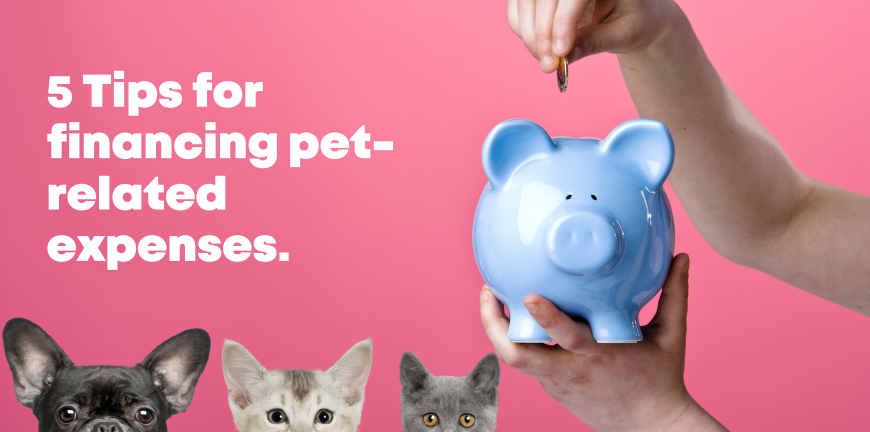December 16, 2021

5 Tips for financing pet-related expenses
5 Tips for financing pet-related expenses.
No matter how much we prepare for life’s uncertainties, sometimes we can’t foresee them until it’s too late. As our pets are such an im-paw-tant part of our life, we can be left feeling confused and overwhelmed when something unexpected happens to them, particularly if it involves huge veterinary bills.
And if you have multiple pets, the costs can really stack up. According to Animal Medicines Australia, ongoing expenditure on pet-related expenses is now estimated at more than $13 billion a year. While food remains the biggest spend, at 30%, it is closely followed by vet services at 20% of people’s total spend.
Two years ago, I was faced with the largest vet bill I’d ever seen when not one, but two of my pets became seriously ill – one with toxoplasmosis and the other with stomach cancer. Obviously, no expense was spared in getting the essential treatment they both needed, but I was looking at north of $8,000 in total. Fortunately, I had some savings, and a kind aunt donated funds, with the rest going on a low-interest credit card. But what do you do if you are on a really tight budget?
To help you plan for these situations, read on to discover our top 5 tips for financing pet-related expenses.
Tip 1 – Set up an emergency fund
If you can spare a little extra change each month to put away in case of unexpected costs, then setting up an emergency fund is ideal. You never know when disaster might strike, so the security of having some money tucked away offers peace of mind. By buying pet food in bulk or ordering online to take advantage of discounts, you can add the cash you saved to your emergency fund. If savings aren’t your thing or you don’t have the income to do this at the moment, read on for some additional ideas.
Tip 2 – Take out a personal loan
While I’d taken out a loan in the past to buy a car, I’d never thought about doing so to pay for pet-related expenses. But with competitive interest rates (some as low as 5.35% p.a.) compared to credit cards and buy-now, pay-later services, a personal loan could actually save you in the long term. Bill Tsouvalas, money expert and Managing Director of Savvy, says that “Personal loans offer flexibility and a good option for dealing with a range of different expenses….If you know you have a significant pet-related expense coming up, planning ahead can save you a lot in the long run.” Before making a decision, it’s important to consider your best personal loan options and do your own research. There are some good rates out there that will help you when you most need it.
Tip 3 – Avoid buy now, pay later plans or credit cards
While buy now, pay later plans allow you to pay in instalments, credit cards are repaid over time with a monthly minimum, plus interest. The trouble with relying on both options is that there’s often a tendency to overspend and if you already find it difficult to budget, they are probably not the best solution for you. While it might be a “bandaid” for dealing with pet-related expenses at the time, the temptation to keep spending when you already owe money could be an issue and lead to more problems in the long run.
Tip 4 – Get pet insurance
Even the major supermarkets offer pet insurance nowadays, so it shouldn’t be hard to find a policy that’s right for you. Many companies offer a month free as an incentive to join and you can find various levels of cover from low to high options. When you consider there is no Medicare for animals, pet insurance is the next best thing! With monthly premiums starting at $25 to insure dogs and $10 for cats, think of it as a savings plan towards costly vet bills. Think about if your cat was struck by a car or your beloved dog was bitten in the park – these unexpected events are not only devastating but are made even more stressful if you are not financially secure. You can even help pets in need while ensuring your own fur friends with the RSPCA, where a portion of your first-year premiums helps those that need it most.
Tip 5 – Crowdfunding for vet bills or treatments
Although I’ve never used crowdfunding to pay for my own veterinary bills, I have donated to many over the years. From horses to humans, cats to canines, I have contributed to everything from life-saving surgery to airfares for pets that have been rescued overseas. It’s amazing to see how many generous people are out there willing to contribute to the veterinary bills of complete strangers. Unfortunately, crowdfunding platforms are occasionally used by people to take advantage of others’ good nature. So if you are planning to crowdfund, you would need to write a truthful and informative description about your situation, including images so that people know you are genuine. Then, spread it far and wide so that it reaches as many people as possible. If you are looking to donate money towards someone else’s veterinary bills, be sure to double-check that they are real and not fake. When used appropriately, crowdfunding is a great way to raise money for a pet’s operation or vet care in times of need.